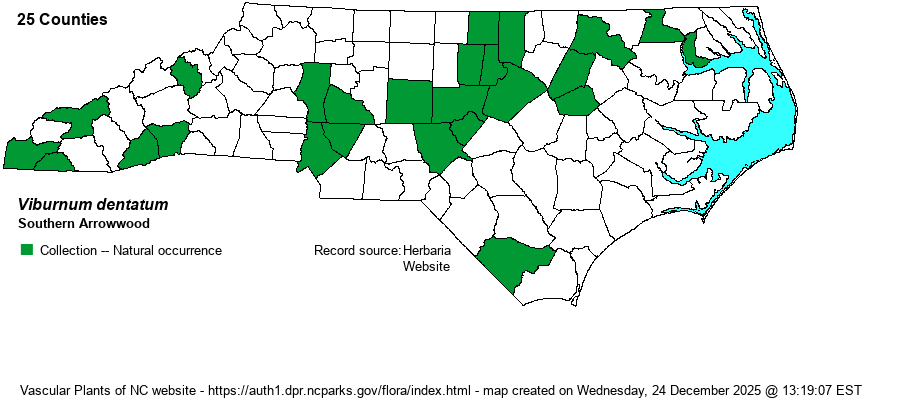| Author | L. | |
| Distribution | This description here refers to the “strict-sense” V. dentatum, which was the former V. dentatum var. dentatum that occurs in the Coastal Plain and Piedmont. This elevated taxon is believed to occur mainly in the central and eastern Piedmont and the northern Coastal Plain, and sparingly in the Mountains. Its range in much of the Coastal Plain is not well known, as a number of records there actually belong to V. recognitum, which see. Weakley's (2024) province range map shows it as "rare" in the Coastal Plain, "uncommon" in the Piedmont, and "rare" in the Mountains. Most specimens from the Coastal Plain in the SERNEC database seem to have been identified as the recently-split V. recognitum -- the former V. dentatum var. lucidum. Nonetheless, the state range map (below) is likely quite incomplete. Records for a few central Mountain counties need to be re-evaluated versus V. carolinianum. Note that -- as most herbaria have not renamed their Viburnum dentatum specimens -- the website editors only used labels with V. dentatum var. dentatum to map the species, as only V. dentatum could refer to several of these elevated species.
This species ranges from southeastern PA and southern NJ south to SC and northern GA, and sparingly westward into the southern Appalachians. However, it is a species mainly of the Piedmont and Coastal Plain.
| |
| Abundance | This is an uncommon species in the (northern) Coastal Plain and Piedmont and southern Mountains. Details of abundance are poorly known owing to recent splits of the former V. dentatum (broad sense). In NC it is much less common than V. recognitum downstate, and V. carolinianum in the southern Mountains. The State Rank of S5 given by the NCNHP seems to be for the former/broad sense V. dentatum; the website editors suggest a State Rank of S3? for now, as the range and abundance is still unsettled. | |
| Habitat | This is a wetland species found in bottomlands, along creek banks, swamps, and wet thickets. Details of its habitats versus V. recognitum, however, are badly needed. |
| Phenology | Blooms in late March and April; fruits from July to September. | |
| Identification | This species is a medium-sized shrub with deciduous, opposite leaves, growing to 8-10 feet tall. It is very similar in appearance to two other species formerly within the V. dentatum complex – V. carolinianum and V. recognitum. From the latter, whose range it broadly overlaps, this species has more rounded/rotund leaves, approaching nearly as wide as long (around 3 inches), and has some pubescence over the underside of the leaves. Viburnum recognitum has ovate leaves that are, based on photos on Google, about 1.5 to approaching 2 times as long as wide; its leaves are mostly glabrous below but have pubescence on some veins and in leaf axils. Viburnum carolinianum has thick leaves with a more sunken vein appearance and is more heavily pubescent below. The similar V. rafinesqueanum, not in this complex, has leaves that are essentially sessile or have very short petioles. | |
| Taxonomic Comments | This species was formerly a part of a very broadly based one, also named as V. dentatum. When split out, this taxon is a more southerly one than is V. recognitum. Note that V. dentatum var. lucidum in RAB (1968) is now named as V. recognitum. Also in RAB (1968), V. dentatum var. dentatum has been split off into V. carolinianum and V. dentatum, with the former being mostly the taxon in the mountains.
| |
| Other Common Name(s) | Arrowwood Viburnum, Roughish Arrowwood, Smooth Arrowwood | |
| State Rank | S5 [S3?] | |
| Global Rank | G5 | |
| State Status | | |
| US Status | | |
| USACE-agcp | FAC link |
| USACE-emp | FAC link |

